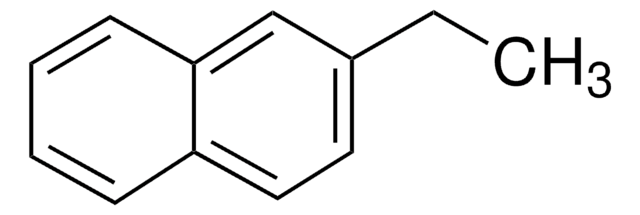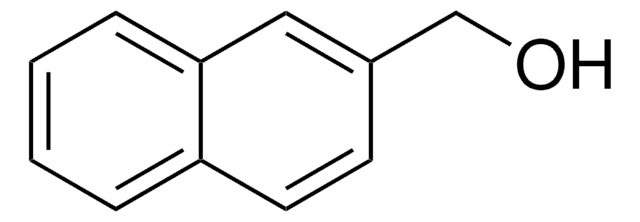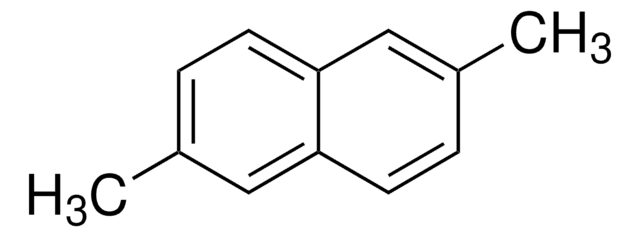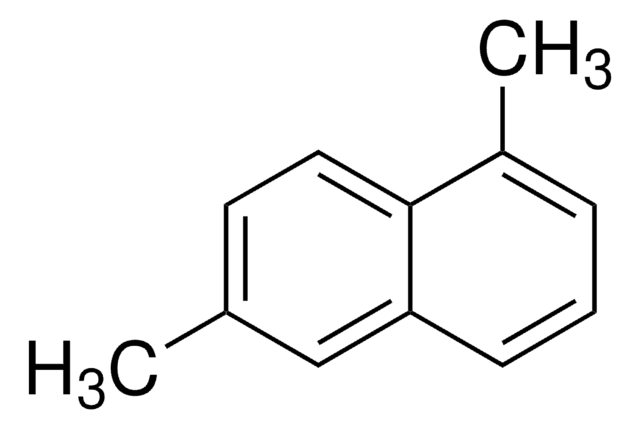M57006
2-Methylnaphthalene (β)
95%
Synonym(s):
β-Methylnaphthalene
Sign Into View Organizational & Contract Pricing
All Photos(3)
About This Item
Linear Formula:
C10H7CH3
CAS Number:
Molecular Weight:
142.20
Beilstein:
906859
EC Number:
MDL number:
UNSPSC Code:
12352100
PubChem Substance ID:
NACRES:
NA.22
Recommended Products
Quality Level
Assay
95%
bp
241-242 °C (lit.)
mp
34-36 °C (lit.)
density
1 g/mL at 25 °C (lit.)
SMILES string
Cc1ccc2ccccc2c1
InChI
1S/C11H10/c1-9-6-7-10-4-2-3-5-11(10)8-9/h2-8H,1H3
InChI key
QIMMUPPBPVKWKM-UHFFFAOYSA-N
Gene Information
human ... CYP1A2(1544) , CYP2A6(1548)
mouse ... Cyp2a5(13087)
Related Categories
Signal Word
Warning
Hazard Statements
Precautionary Statements
Hazard Classifications
Acute Tox. 4 Oral - Aquatic Chronic 2 - Eye Irrit. 2 - Skin Irrit. 2 - STOT SE 3
Target Organs
Respiratory system
Storage Class Code
11 - Combustible Solids
WGK
WGK 2
Flash Point(F)
208.4 °F - closed cup
Flash Point(C)
98.0 °C - closed cup
Personal Protective Equipment
dust mask type N95 (US), Eyeshields, Gloves
Choose from one of the most recent versions:
Already Own This Product?
Find documentation for the products that you have recently purchased in the Document Library.
Customers Also Viewed
Michael Safinowski et al.
Environmental microbiology, 8(2), 347-352 (2006-01-21)
The sulfate-reducing culture N47 can utilize naphthalene or 2-methylnaphthalene as the sole carbon source and electron donor. Here we show that the initial reaction in the naphthalene degradation pathway is a methylation to 2-methylnaphthalene which then undergoes the subsequent oxidation
Michael Safinowski et al.
Environmental science & technology, 40(13), 4165-4173 (2006-07-25)
The sulfate-reducing enrichment culture N47 can grow on naphthalene or 2-methylnaphthalene as the sole carbon and energy source. Here we show that the culture can furthermore cometabolicallytransform a variety of polycyclic and heteroaromatic compounds with naphthalene or methylnaphthalene as the
Young-Bum Kim et al.
Applied biochemistry and biotechnology, 159(1), 1-10 (2009-02-14)
Amphiphilic polyurethane (APU) nano-particle enhanced the mobilization of 2-methylnaphthalene (2-MNPT) in soil. Significant increase in the solubility of 2-MNPT was achieved. The molar solubilization ratio was 0.4 (mole 2-MNPT/mole APU). Simple precipitation of APU particle by 2 N CaCl(2) recovered
Raymond J DiDonato et al.
PloS one, 5(11), e14072-e14072 (2010-12-03)
Anaerobic polycyclic hydrocarbon (PAH) degradation coupled to sulfate reduction may be an important mechanism for in situ remediation of contaminated sediments. Steps involved in the anaerobic degradation of 2-methylnaphthalene have been described in the sulfate reducing strains NaphS3, NaphS6 and
Radosław Swiercz et al.
International journal of occupational medicine and environmental health, 23(4), 385-389 (2011-02-11)
The aim of the study was to evaluate the toxicokinetics of 2-methylnaphtalene (2-MN) during and after inhalation exposure. Male Wistar rats were exposed to 2-MN vapours at nominal concentrations of 200 or 400 mg/m3 in the dynamic inhalation chamber for
Our team of scientists has experience in all areas of research including Life Science, Material Science, Chemical Synthesis, Chromatography, Analytical and many others.
Contact Technical Service












